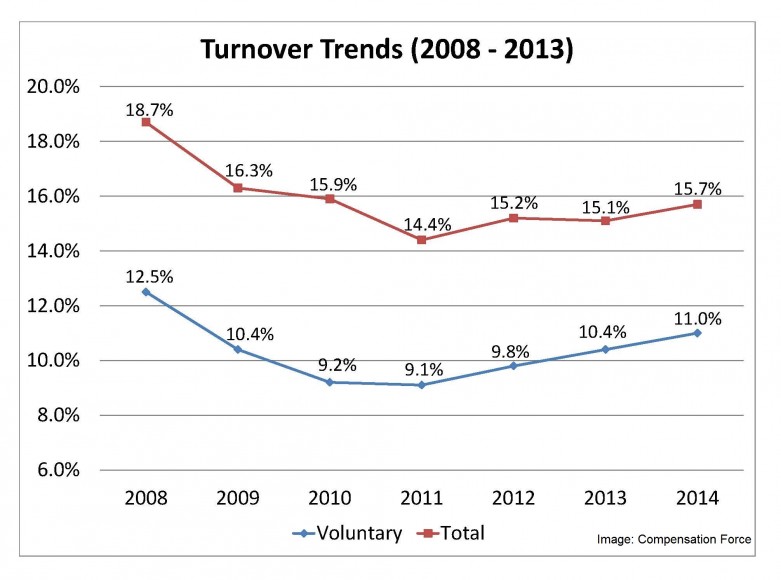Your Best Employees Are Going to Leave – and That’s Okay

Once upon a time, an employee joined a company and stayed for life. Those days are over, and they will probably never come back, but many companies today have yet to embrace this fact. Their structures and HR processes treat turnover as the exception, rather than the norm. Operating as if employees will stay for decades sets everyone up for failure when those employees inevitably move on.
As the economy has improved, voluntary turnover has grown by 2 percent across all industries. While specific data on turnover in the technology sector is as clear as mud, what is well understood is that top talent can move around at will. The best knowledge workers are highly mobile. You should recognize that your star players are being hit up on a regular basis with offers to jump ship. Everyone with a LinkedIn profile is a passive candidate, making it easy for recruiters to find them. As one recruiter put it: “If you’re not a client, you’re a source.”

Image Credit: Compensation Force
During an interview on the Tim Ferriss Show, Evernote cofounder Phil Libin talked about the trend: “Basically everyone is acting like a freelancer. Everyone is doing a job. They don’t think they’re going to do it forever; they think they’re going to do it for a couple of years and then they’re moving on to the next one. That’s happening like crazy here in Silicon Valley, and it’s starting to happen everywhere.”
Fighting this trend is a waste of effort. If tech titans like Google, Apple, and Amazon can’t retain employees even with high salaries, highly visible projects, and lavish benefits, thinking that your company will be the exception is foolish.
A more realistic goal is to embrace the trend and try to benefit from it as a company. Here are three ideas to think about:
1. Make a Turnover Binder and Keep Current Documentation
You need to be ready for any employee to leave at any time. For anyone who comes from a military background, this type of thinking is second nature. A specific set of orders typically only lasts for 2-3 years. Turnover within the organization is a part of life, and thus you are always preparing to hand over the office keys to your successor. The best turnovers give you a few weeks of time to work together and gradually come up to speed. The worst are “high-five turnovers” where you show up, your predecessor throws you a high-five on their way out the door, and now you’re in charge without any chance to get acclimated.
It doesn’t have to be that way, though. There’s no reason why you shouldn’t have documentation ready to go for the day-to-day duties of key employees. Policies and procedures should be accessible to everyone all the time. Onboarding new team members will go much more quickly if they have key pieces of information at their fingertips on day one.
At the same time, maintaining documentation on your infrastructure, licenses, and other technical information is critical. There is no excuse for this information being disorganized or out of date. If it is, that puts you at major risk if a key player suddenly leaves. Keeping this information organized and up to date may be a bigger challenge than just gathering it in one place. You need to think of this as a perpetual effort to maintain accurate documentation.
As an added bonus, getting all of this information in one place will assist you in the event of an outage or major incident. Having this at your fingertips may make a huge difference if you ever need to break out your business continuity plan.
2. Embrace the Opportunity to Make Changes
Employee turnover presents a natural opportunity to introduce changes to your organization. There is no “we used to do it this way” when you don’t have a lot of long-term employees around. Change is not a bad thing; you should see it as an opportunity to improve your business and incorporate new ideas every time you have a new hire coming in the door.

Whenever you have turnover in a key role, you need to think about where improvements can be made in that part of your business. No organization is perfect, and accelerating your evolution as a company gives you an opportunity to better adapt to the world around you.
3. Consider Adopting “Tours of Duty”
If you are ready to truly embrace the freelancer mentality, then it is time to start thinking about how to build roles that attract the best knowledge workers. Here’s where you need to get HR involved.
In their book The Alliance , Reid Hoffman, Ben Casanocha, and Chris Yeh discuss an in-depth model for how to deal with a world in which everyone thinks of themselves as a freelancer. Their core concept of hiring folks to accomplish specific tasks involves thinking about each role as a “tour of duty.” This allows you to think about how each team member can contribute to the company while also growing their skills and meeting their personal objectives over a shorter period of time than a career.
In a 2013 Harvard Business Review article, Hoffman, Casnocha, and Yeh explain this idea very succinctly: “You can’t have an agile company if you give employees lifetime contracts – and the best people don’t want one employer for life anyway. But you can build a better compact than ‘every man for himself.'”
One of the best ways to start thinking about this is to study your organizational design and update your job descriptions. Are the roles you have aligned with where you want to go? Do the descriptions accurately describe the work your team is doing today and signal their strengths? Are you providing a growth path for people to follow as they are “on tours” in your organization? Maybe it’s time to sit down and consider what could be done differently.
A version of this post originally appeared on the Systems Alliance blog.

